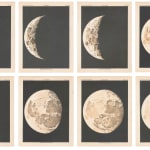Sir Robert Stawell Ball
The Phases of the Moon, 1893
17 x 40 in
43 x 102 cm
54 x 120 cm (framed)
43 x 102 cm
54 x 120 cm (framed)
CELEST1594
Further images
-
(View a larger image of thumbnail 1
)

-
(View a larger image of thumbnail 2
)

-
(View a larger image of thumbnail 3
)

-
(View a larger image of thumbnail 4
)

-
(View a larger image of thumbnail 5
)

-
(View a larger image of thumbnail 6
)

-
(View a larger image of thumbnail 7
)

-
(View a larger image of thumbnail 8
)

-
(View a larger image of thumbnail 9
)

-
(View a larger image of thumbnail 10
)

-
(View a larger image of thumbnail 11
)

-
(View a larger image of thumbnail 12
)

-
(View a larger image of thumbnail 13
)

A set of 12 moon phases showing the changing face of the moon from the 3rd day to the 14th day of the Lunar cycle, changing from a slim crescent...
A set of 12 moon phases showing the changing face of the moon from the 3rd day to the 14th day of the Lunar cycle, changing from a slim crescent moon to the full moon. By Irish astronomer, Sir Robert Stawell Ball (1840-1913).
Ball started his career in astronomy in 1865 working for Lord Rosse (William Parsons, 3rd Earl of Rosse). In 1845, Rosse had commissioned to build of the world's largest telescope, known as the Leviathan of Parsonstown - a six-foot reflecting telescope that remained the largest in the world until 1917 when the Hooker Telescope was built in California.
In 1874, Ball was appointed Royal Astronomer of Ireland and in 1881, Ball was invited to give the prestigious Christmas Lecture at The Royal Institution. Titled "The Sun, The Moon and the Planets" - it was so popular that he was invited back to give a further four Christmas lectures in 1887, 1892, 1898 and 1900. In his lifetime it is said he gave an estimated 2500 lectures on popular science.
A minor planet is named 4809 Robertball, in his honour.
Framed together as a set. [CELEST1594]
Ball started his career in astronomy in 1865 working for Lord Rosse (William Parsons, 3rd Earl of Rosse). In 1845, Rosse had commissioned to build of the world's largest telescope, known as the Leviathan of Parsonstown - a six-foot reflecting telescope that remained the largest in the world until 1917 when the Hooker Telescope was built in California.
In 1874, Ball was appointed Royal Astronomer of Ireland and in 1881, Ball was invited to give the prestigious Christmas Lecture at The Royal Institution. Titled "The Sun, The Moon and the Planets" - it was so popular that he was invited back to give a further four Christmas lectures in 1887, 1892, 1898 and 1900. In his lifetime it is said he gave an estimated 2500 lectures on popular science.
A minor planet is named 4809 Robertball, in his honour.
Framed together as a set. [CELEST1594]
Join our mailing list
* denotes required fields
We will process the personal data you have supplied to communicate with you in accordance with our Privacy Policy. You can unsubscribe or change your preferences at any time by clicking the link in our emails.














